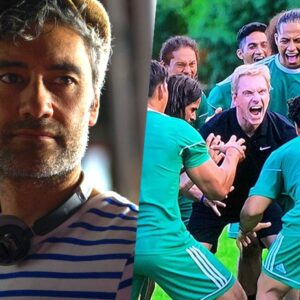
At the front of the Woodland Cultural Centre auditorium, 3-year-old Vivien Menoz-Johnson, a ballet student herself, twirled, bounced and danced. She was beaming in anticipation of Santee Smith’s performance of Re-Quickening last Saturday night.
“Oh, she was just like me at her age,” laughs Santee after her program. “So young with no self doubt!”
 Santee’s performances, on Jan. 23 and 24, drew large, appreciative audiences. They were part of a multi-media exhibition of her art, pottery and videos at the Woodland Cultural Centre entitled, No Word for Art. Her credits include writing, acting, producing, choreography and photography. The exhibit continues through May 8.
Santee’s performances, on Jan. 23 and 24, drew large, appreciative audiences. They were part of a multi-media exhibition of her art, pottery and videos at the Woodland Cultural Centre entitled, No Word for Art. Her credits include writing, acting, producing, choreography and photography. The exhibit continues through May 8.
During Re-Quickening, Santee used dance and spoken word to examine the experiences of indigenous women. The performance began with the pre-contact era and took the audience through the imposition of the Indian Act, gentrification and the horror of residential schools. Through movement and expression, she shares joy, desolation, and, finally, healing.
“It’s all a cycle, really,” she notes. “Birth, death and life again.”
“Before contact, our women were great leaders in our communities, but much of this was crushed with the arrival of the Europeans. The Victorian dress I wear features quotes from the 1876 Indian Act, which didn’t even recognize us as people. It reminds me of how our women are now being treated, our murdered and missing women, as well as how the earth is being mistreated.”
But in the end, there is healing, symbolized by the reconstruction of a broken piece of pottery, “and I wanted it to end with that message.”
Santee smiles when she speaks of her early years as a proud member of the Kanien’kehá:ka nation Turtle Clan.
“I loved growing up here on Six Nations,” she recalls.
“We lived on the Second Line, behind St. Paul’s Church. There were woods and forests out back that seemed so huge to me. I remember the open area close to Sour Springs with sand and pine trees. We’d pick up the fallen sticks and taste the wood.”
“My Uncle Bill would tap the maple trees in the bush and boil the sap in enormous vats. So many memories.”
Arts and pottery played an important role in her upbringing. Santee’s parents were both gifted potters. Her paternal grandmother, Elda M. Smith, was renowned for her pottery. Her maternal grandmother, Rita Vyse, was well known for her cornhusk dolls and handmade creations.
“They all worked creating with their hands, and that was a big influence for me.”
An accident at the age of two left her with broken legs, in traction and a body cast. Doctors encouraged her parents, Steve and Leigh Smith, to enrol her in activities to strengthen her legs.
“For me, dancing and figure skating were natural choices,” she explains. “I remember my parents driving me to the arena for skating and to dance lessons.”
Santee studied dance in Brantford, where her extraordinary gifts became evident.
“My parents took me to a production of Swan Lake at the O’Keefe Centre in Toronto when I was 10-years-old, and I fell in love with ballet,” she remembers.
The following spring, Santee auditioned and was accepted into the National Ballet of Canada’s Summer School. By Christmas, she was dancing on the O’Keefe stage with the company in The Nutcracker.
It was difficult to leave family and friends behind to study dance in Toronto. “As an only child, I felt very homesick. It was devastating for my parents.”
Through hard work and perseverance, Santee evolved from dancing into choreography before finally heading home.
“I returned home to Six Nations 16 years ago to raise my daughter, Semiah. And now she’s following in her family’s footsteps, working in visual art, pottery, film and animation.”
Now she is an award-winning dancer, producer and choreographer. She is the artistic director of the world-famous Kaha:wi Dance Theatre. The celebrated troupe begins its next tour at the Sanderson Centre on Feb. 20, with a production of TransMigration, a celebration of Ojibwe shaman/artist Norval Morrisseau.
“My message to young people is to keep following your own path. My journey came down to having a vision, plus doing an awful lot of hard work. It’s important to dream, but you must also do. You must act on that dream.”
Santee’s mother told her that she should do one creative thing, something that takes her further on her journey, each and every day.
Such sage advice has taken this proud, inspiring Mohawk artist a long way on her journey.











